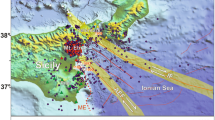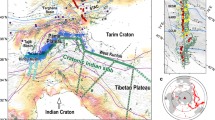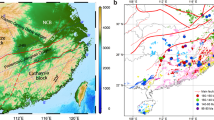Abstract
No large tsunamigenic earthquake has occurred in north Chile since 1877 and the region has been largely recognized as a mature seismic gap1,2,3,4,5,6,7,8,9. At the southern end of the seismic gap, the 2007 Mw 7.7 Tocopilla earthquake ruptured the deeper seismogenic interface, whereas the coupled upper interface remained unbroken4,6,7. Seismological studies onshore show a gently varying dip of 20° to 30° of the downgoing Nazca plate3,6, which extends from the trench down to depths of 40–50 km. Here, we study the lithospheric structure of the subduction zone of north Chile at about 22° S, using wide-angle seismic refraction and reflection data from land and sea, complemented by hypocentre data recorded during the 2007 Tocopilla aftershocks7. Our data document an abrupt increase in the dip of the subducting plate, from less than 10° to about 22°, at a depth of approximately 20 km. The distribution of the 2007 aftershocks indicates that the change in dip acted as a barrier for the propagation of the 2007 earthquake towards the trench, which, in turn, indicates that the subduction megathrust is not only segmented along the trench, but also in the direction of the dip. We propose that large-magnitude tsunamigenic earthquakes must cross the barrier and rupture the entire seismogenic zone.
This is a preview of subscription content, access via your institution
Access options
Subscribe to this journal
Receive 12 print issues and online access
$259.00 per year
only $21.58 per issue
Buy this article
- Purchase on Springer Link
- Instant access to full article PDF
Prices may be subject to local taxes which are calculated during checkout



Similar content being viewed by others
References
Comte, D. & Pardo, M. Reappraisal of great historical eathquakes in northern Chile and southern Peru seismic gaps. Nat. Hazards 4, 23–44 (1991).
Dorbath, L., Cisternas, A. & Dorbath, C. Quantitative assessment of great earthquakes in Peru. Bull. Seismol. Soc. Am. 80, 551–576 (1990).
Husen, S., Kissling, E. & Flueh, E. Local earthquake tomography of shallow subduction in north Chile: A combined onshore and offshore study. J. Geophys. Res. 105, 28183–28198 (2000).
Béjar-Pizarro, M. et al. Asperities and barriers on the seismogenic zone in north Chile: State-of-the-art after the 2007 Mw 7.7 Tocopilla earthquake nferred by GPS and InSAR data. Geophys. J. Int. 183, 390–406 (2010).
Klotz, J. et al. Earthquake cycle dominates contemporary crustal deformation in central and southern Andes. Earth Planet. Sci. Lett. 193, 437–446 (2001).
Delouis, B., Pardo, M., Legrand, D. & Monfret, T. The Mw 7.7 Tocopilla earthquake of 14 November 2007 at the southern edge of the northern Chile seismic gap: Rupture in the deep part of the coupled plate interface. Bull. Seismol. Soc. Am. 99, 87–94 (2009).
Peyrat, S. et al. Kinematic rupture process of the 2007 Tocopilla earthquake and its main aftershocks from teleseismic and strong-motion data. Geophys. J. Int. 182, 1411–1430 (2010).
Malgrange, M. & Madariaga, R. Complex distribution of large thrust and normal fault earthquakes in the Chilean subduction zone. Geophys. J. R. Astron. Soc. 73, 489–505 (1983).
Chlieh, et al. Interseismic coupling and seismic potential along the central Andes subduction zone. J. Geophys. Res. 116, B12405 (2011).
Robinson, D. P., Das, S. & Watts, A. B. Earthquake rupture stalled by a subducting fracture zone. Science 312, 1203–1205 (2006).
Scheuber, E., Bogdanic, T., Jensen, A. & Reutter, K-J. Tectonics of the Southern Central Andes 121–139 (Springer, 1994).
Allmendinger, R. & Gonzalez, G. Neogene to Quaternary tectonics of the Coastal Cordillera, northern Chile. Tectonophysics 495, 93–110 (2010).
Allmendinger, et al. Trench-parallel shortening in the northern Chilean forearc: Tectonic and climatic implications. GSA Bull. 117, 89–104 (2005).
Hartley, A. J. et al. Development of a continental forearc: A Cenozoic example from the central Andes, northern Chile. Geology 28, 331–334 (2000).
Armijo, R. & Thiele, R. Active faulting in northern Chile: Ramp stacking and lateral decoupling along a subduction plate boundary? Earth Planet. Sci. Lett. 98, 40–61 (1990).
Mortimer, C. & Saric, N. Cenozoic studies in northernmost Chile. Geologishe Rundschau 64, 395–420 (1975).
Paskoff, R. Sobre la Evolución Geomorfológica del Gran Acantilado Costero del Norte Grande de Chile PhD thesis, Univ. Católica de Chile (1979).
Gonzalez, G., Cembrano, J., Carrizo, D., Macci, A. & Schneider, H. The link between forearc tectonics and Pliocene Quaternary deformation of the Coastal Cordillera, northern Chile. J. S. Am. Earth Sci. 16, 321–342 (2003).
Patzwahl, R., Mechie, J., Schulze, A. & Giese, P. Two-dimensional velocity models of the Nazca plate subduction zone between 19.5° S and 25° S from wide-angle seismic measurements during the CINCA95 project. J. Geophys. Res. 104, 7293–7317 (1999).
Sallares, V. & Ranero, C. R. Structure and tectonics of the erosional convergent margin off Antofagasta, north Chile (23° 30′S). J. Geophys. Res. 110, B06101 (2005).
ANCORP Working Group Seismic reflection image revealing offset of Andean subduction-zone earthquake locations into oceanic mantle. Nature 397, 341–344 (1999).
Von Huene, R. & Ranero, C. R. Subduction erosion and basal friction along the sediment-starved convergent margin off Antofagasta, Chile. J. Geophys. Res. 108, 2079 (2003).
Ito, A. et al. Bending of the subducting oceanic plate and its implication for rupture propagation of large interplate earthquakes off Miyagi, Japan, in the Japan trench subduction zone. Geophys. Res. Lett. 32, L05310 (2005).
Fujie, G. et al. Confirming sharp bending of the Pacific plate in the northern Japan trench subduction zone by applying a traveltime mapping method. Phys. Earth Planet. Int. 157, 72–85 (2006).
Von Huene, R., Weinrebe, W. & Heeren, F. Subduction erosion along the north Chile margin. J. Geodynam. 27, 345–358 (1999).
Gonzalez, L., Dunai, G. T., Carrizo, D. & Allmendinger, R. Young displacements on the Atacama fault system, northern Chile from field observations and cosmogenic 21Ne concentrations. Tectonics 25, TC3006 (2006).
Delouis, B., Philip, H., Dorbath, L. & Cisternas, A. Recent crustal deformation in the Antofagasta region (northern Chile) and the subduction process. Geophys. J. Int. 132, 302–338 (1998).
Gonzalez, G. & Carrizo, D. Segmentación, cinemática y chronología relativa de la deformación tardía de la Falla Salar del Carmen, Sistema de Fallas Atacama, (23° 40′ S), norte de Chile. R. Geol. Chile 30, 223–244 (2003).
Marquardt, C., Lavenu, A., Ortliebc, L., Godoya, E. & Comte, D. Coastal neotectonics in southern central Andes: Uplift and deformation of marine terraces in northern Chile (27° S). Tectonophysics 394, 193–219 (2004).
Acknowledgements
E.C-R. acknowledges the support of the Chilean National Science Foundation (FONDECYT) project 11090009. S.R and D.C acknowledge the support of FONDECYT project 1100429. We thank A. Fuenzalida, M. Lancieri and R. Madariaga for providing the hypocentre data. Marine data acquisition was financially supported by the German Ministry of Education, Science and Research. We also thank GeoForschungZentrum, Potsdam and the International Plate Boundary Observatory Chile for sharing the data.
Author information
Authors and Affiliations
Contributions
E.C-R., J.J. and I.G. analysed and processed the wide-angle seismic data. E.C-R., S.R., D.C. and I.G. interpreted and wrote the paper.
Corresponding authors
Ethics declarations
Competing interests
The authors declare no competing financial interests.
Supplementary information
Supplementary Information
Supplementary Information (PDF 17470 kb)
Rights and permissions
About this article
Cite this article
Contreras-Reyes, E., Jara, J., Grevemeyer, I. et al. Abrupt change in the dip of the subducting plate beneath north Chile. Nature Geosci 5, 342–345 (2012). https://doi.org/10.1038/ngeo1447
Received:
Accepted:
Published:
Issue Date:
DOI: https://doi.org/10.1038/ngeo1447
This article is cited by
-
Subduction zone fluids and arc magmas conducted by lithospheric deformed regions beneath the central Andes
Scientific Reports (2021)
-
Rise of the central Andean coast by earthquakes straddling the Moho
Nature Geoscience (2016)
-
Diversity of the 2014 Iquique’s foreshocks and aftershocks: clues about the complex rupture process of a Mw 8.1 earthquake
Journal of Seismology (2016)
-
Subducting seamounts control interplate coupling and seismic rupture in the 2014 Iquique earthquake area
Nature Communications (2015)
-
Andean structural control on interseismic coupling in the North Chile subduction zone
Nature Geoscience (2013)



